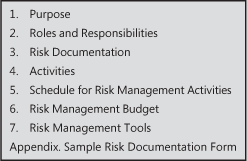Risk management is the application of appropriate tools and procedures to contain risk within acceptable limits. As with other project activities, begin risk management by developing a plan. The work aids that accompany this book include a risk management plan template; an outline of this template appears in Figure 6-1. The template document includes guidance that describes how to complete each section. This template is suitable for larger projects. Small projects can include a concise risk management plan as a section within the overall project management plan.
Risk management consists of the subactivities illustrated in Figure 6-2 and described in the next section (Boehm 1989).
Risk assessment is the process of examining a project to identify areas of potential risk. Risk identification can be facilitated with the help of a checklist of common risk areas for software projects, such as the brief lists presented in this chapter. You might also study an organization-wide compilation of previously identified risks and mitigation strategies, both successful and unsuccessful. Risk analysis examines how project outcomes might change as a result of the identified risks.
Risk prioritization helps the project focus on its most severe risks by assessing the risk exposure. Exposure is the product of the probability of incurring a loss due to the risk and the potential magnitude of that loss. I usually estimate the probability from 0.1 (highly unlikely) to 1.0 (certain to happen), and the loss (also called impact) on a relative scale of 1 (no problem) to 10 (deep tapioca). Multiplying these factors together provides an estimate of the risk exposure due to each item, which can run from 0.1 (don’t give it another thought) through 10 (stand back, here it comes!). It’s simpler to estimate both probability and loss as High, Medium, or Low. Table 6-1 shows how you can estimate the risk exposure level as High, Medium, or Low by combining the probability and loss estimates. It’s also a good idea to consider the time horizon during which a risk might pose a threat. Confront imminent risks more aggressively than those for which you still have some breathing space.
Risk avoidance is one way to deal with a risk: don’t do the risky thing! You might avoid risks by not undertaking certain projects, or by relying on proven rather than cutting-edge technologies when possible. In certain situations you might be able to transfer a risk to some other party, such as a subcontractor.
Risk control is the process of managing risks to achieve the desired outcomes. Risk management planning produces a plan for dealing with each significant risk, including mitigation approaches, owners, and timelines. Risk resolution entails executing the plans for dealing with each risk. Finally, risk monitoring involves tracking your progress toward resolving each risk item.
Let’s look at an example of risk management planning. Suppose the "project" is to take a hike through a swamp in a nature preserve. You’ve been warned that the swamp might contain quicksand. So the risk is that we might step in quicksand and be injured or even die. One strategy to mitigate this risk is to reduce the probability of the risk actually becoming a problem. A second option is to consider actions that could reduce the impact of the risk if it does in fact become a problem. So, to reduce the probability of stepping in the quicksand, we might be on the alert, looking for signs of quicksand as we walk, and we might draw a map of the swamp so we can avoid these quicksand areas on future walks. To reduce the impact if someone does step in quicksand, perhaps the members of the tour group should rope themselves together. That way if someone does encounter some quicksand the others could quickly pull him to safety. In that way we reduce the impact of stepping in the quicksand. Although, of course, we still stepped in the quicksand.
Even better, is there some way to prevent the risk from becoming a problem under any circumstances? Maybe we build a boardwalk as we go so we avoid the quicksand. That will slow us down and it will cost some money. But, we don’t have to worry about quicksand any more. The very best strategy is to eliminate the root cause of the risk entirely. Perhaps we should drain the swamp, but then it wouldn’t be a very interesting nature walk. By taking too aggressive a risk approach, you can eliminate the factors that make a project attractive in the first place.


